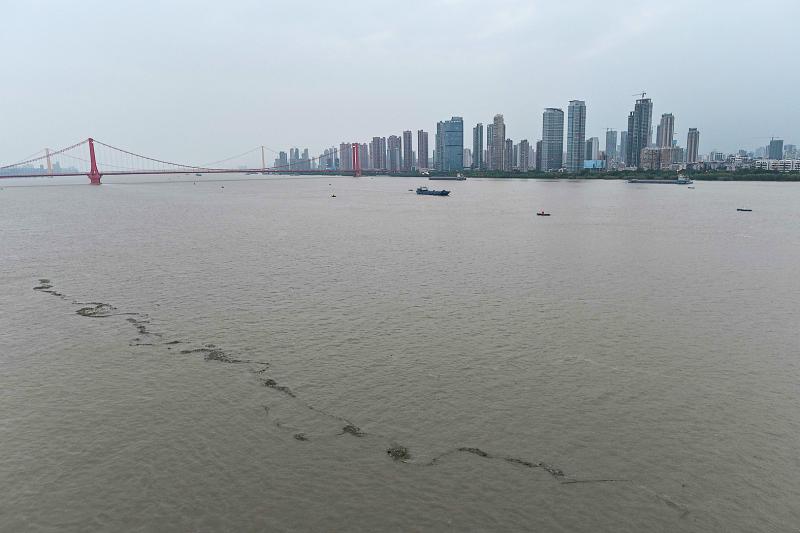Large parts of central and eastern China were reeling yesterday from the worst floods in decades as disruption mounted for key supply chains, including personal protective equipment (PPE) amid the COVID-19 pandemic.
The city of Wuhan and the provinces of Anhui, Jiangxi and Zhejiang declared red alerts as heavy rain swelled rivers and lakes.
Wuhan, on the banks of the Yangtze River where COVID-19 emerged late last year, warned residents to take precautions as water levels approached their maximum guaranteed safety level.

Photo: AFP
The Three Gorges reservoir, which has been holding back more water to try to ease downstream flood risks, was more than 10m higher than its warning level, with inflows now at more than 50,000m3 a second.
The Poyang Lake in Jiangxi Province, which is formed from the overspill of the Yangtze, was 2.5m higher than its warning level. It has expanded by more than 2,000km2 during this flood season, and parts of the surrounding town have been inundated.
Further east, the Tai Lake near Shanghai has also declared a red alert after its water level rose to nearly 1m higher than its safe level.
The summer rainy season brings floods to China almost every year, but the impact of the disruption they cause is being felt further afield as Chinese goods become more important in supply chains of items such as PPE.
“It’s just creating another major roadblock here in terms of PPE getting into the United States — it is the worst of times for it to happen, but that’s what we’re dealing with right now,” said Michael Einhorn, president of Dealmed, a US medical supply distributor that sources disposable lab coats and other products from Wuhan and nearby regions.
“We cannot get product out for over a week, which is a very long time in our business,” Einhorn said, adding that the delays could last for up to another three weeks.
Economic activity in eastern and central China, especially in the construction industry, and demand for steel and cement continue to be hurt by the flooding, analysts say, suggesting some loss of momentum after a relatively strong recovery in the second quarter.
“We estimate recent floods in Yangtze River regions could lead to a gross drag of 0.4 to 0.8 percentage points on third-quarter GDP growth,” analysts at Morgan Stanley said in a note to clients.

‘SHORTSIGHTED’: Using aid as leverage is punitive, would not be regarded well among Pacific Island nations and would further open the door for China, an academic said New Zealand has suspended millions of dollars in budget funding to the Cook Islands, it said yesterday, as the relationship between the two constitutionally linked countries continues to deteriorate amid the island group’s deepening ties with China. A spokesperson for New Zealand Minister of Foreign Affairs Winston Peters said in a statement that New Zealand early this month decided to suspend payment of NZ$18.2 million (US$11 million) in core sector support funding for this year and next year as it “relies on a high trust bilateral relationship.” New Zealand and Australia have become increasingly cautious about China’s growing presence in the Pacific

The team behind the long-awaited Vera Rubin Observatory in Chile yesterday published their first images, revealing breathtaking views of star-forming regions as well as distant galaxies. More than two decades in the making, the giant US-funded telescope sits perched at the summit of Cerro Pachon in central Chile, where dark skies and dry air provide ideal conditions for observing the cosmos. One of the debut images is a composite of 678 exposures taken over just seven hours, capturing the Trifid Nebula and the Lagoon Nebula — both several thousand light-years from Earth — glowing in vivid pinks against orange-red backdrops. The new image

ESPIONAGE: The British government’s decision on the proposed embassy hinges on the security of underground data cables, a former diplomat has said A US intervention over China’s proposed new embassy in London has thrown a potential resolution “up in the air,” campaigners have said, amid concerns over the site’s proximity to a sensitive hub of critical communication cables. The furor over a new “super-embassy” on the edge of London’s financial district was reignited last week when the White House said it was “deeply concerned” over potential Chinese access to “the sensitive communications of one of our closest allies.” The Dutch parliament has also raised concerns about Beijing’s ideal location of Royal Mint Court, on the edge of the City of London, which has so

Canada and the EU on Monday signed a defense and security pact as the transatlantic partners seek to better confront Russia, with worries over Washington’s reliability under US President Donald Trump. The deal was announced after a summit in Brussels between Canadian Prime Minister Mark Carney and European Commission President Ursula von der Leyen and European Council President Antonio Costa. “While NATO remains the cornerstone of our collective defense, this partnership will allow us to strengthen our preparedness ... to invest more and to invest smarter,” Costa told a news conference. “It opens new opportunities for companies on both sides of the